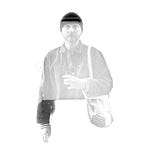On The Road. Nicholas Ray’s They Live By Night.
“If the cinema no longer existed, Nicholas Ray alone gives the impression of being capable of reinventing it, and what is more, of wanting to.” So wrote Jean-Luc Godard in 1957, within the pages of Cahiers du Cinéma, before positing that, unlike his contemporaries such as Ford or Fuller, Aldrich or Taschlin, Nicholas Ray is “something which exists only in the cinema”. The director’s 1948 film, They Live By Night is a work of staggering brilliance made all the more impressive due to the fact that it stands as a debut picture. Ray arrived to direction fully-formed. They Live By Night oozes confidence, with the director not afraid to challenge the conventions of the medium’s form. Ambitious helicopter shots introduce the picture, while his camera finds its way in to the closest of spaces, rendering the viewer near complicit as spectator.
It’s this approach to technique that Godard and the other filmmakers of the Nouvelle Vague would go on to pilfer from Ray. See, the manner in which he shoots a car chase, deep from within the backseat of a fleeing car. His figures serve as allegories, small men and women who stand for something more epic in scope than may seem on the surface. Edward Anderson’s source material novel, Thieves Like Us, which also served as the basis for Robert Aldrich’s film of the same name in 1974, is one of the perennial works of the Depression-era, with his protagonists symbols of the hopeless-hope that seemed doom to fail due to no fault of their own. There’s a real sense of innocence to the film’s two young leads, played by Cathy O’Donnell and Farley Granger, with the two making for genuine pioneers for the teen pics that would follow in the 1950s (with the height of sub-genre coming in the form of Ray’s own Rebel Without A Cause). Granger’s is a particularly eclectic performance, with his turn veering from the Robert Bresson “Model” school of acting to bona-fide Jimmy Stewart-esque All-American boy. Similarly the realism of the handheld camerawork is countered by near-fairytale interludes, such as the visit to a neon-lit all-night wedding parlour (a moment which brings to mind F.W. Murnau and Sunrise), or the trip to a park that looks like something from an Impressionism painting.
That Ray managed to pull of such a competent and well-structured picture so early on in his career will never cease to amaze, with the film’s technical ability matched by an emotional core that affects on a surprisingly heavy scale. There’s a sadness of inevitability in the path taken by our young lovers on the run, one that we know can’t end well, but one which we can’t help but approach with a level of hope and ambition befitting the era which borne They Live By Night.
